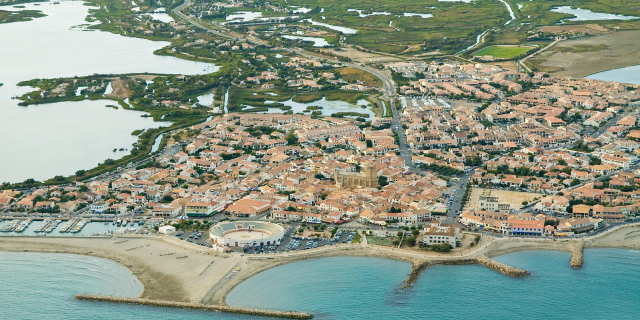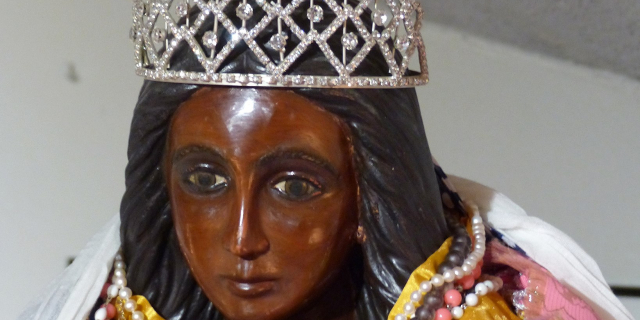Basilique Notre-Dame-de-la-Garde
( Notre-Dame de la Garde )
Notre-Dame de la Garde (literally: Our Lady of the Guard), known to local citizens as la Bonne Mère (French for 'the Good Mother'), is a Catholic basilica in Marseille, France, and the city's best-known symbol. The site of a popular Assumption Day pilgrimage, it is the most visited site in Marseille. It was built on the foundations of an ancient fort at the highest natural point in Marseille, a 149 m (489 ft) limestone outcropping on the south side of the Old Port of Marseille.
Construction of the basilica began in 1853 and lasted for over forty years. It was originally an enlargement of a medieval chapel but was transformed into a new structure at the request of Father Bernard, the chaplain. The plans were made and developed by the architect Henri-Jacques Espérandieu. It was consecrated while still unfinished on 5 June 1864. The basilica consists of a lower church or crypt in the Romanesque style, carved from the rock, and an uppe...Read more
Notre-Dame de la Garde (literally: Our Lady of the Guard), known to local citizens as la Bonne Mère (French for 'the Good Mother'), is a Catholic basilica in Marseille, France, and the city's best-known symbol. The site of a popular Assumption Day pilgrimage, it is the most visited site in Marseille. It was built on the foundations of an ancient fort at the highest natural point in Marseille, a 149 m (489 ft) limestone outcropping on the south side of the Old Port of Marseille.
Construction of the basilica began in 1853 and lasted for over forty years. It was originally an enlargement of a medieval chapel but was transformed into a new structure at the request of Father Bernard, the chaplain. The plans were made and developed by the architect Henri-Jacques Espérandieu. It was consecrated while still unfinished on 5 June 1864. The basilica consists of a lower church or crypt in the Romanesque style, carved from the rock, and an upper church of Neo-Byzantine style decorated with mosaics. A square 41 m (135 ft) bell tower topped by a 12.5 m (41 ft) belfry supports a monumental 11.2 m (37 ft) statue of the Madonna and Child, made of copper gilded with gold leaf.
An extensive restoration from 2001 to 2008 included work on mosaics damaged by candle smoke, green limestone from Gonfolina which had been corroded by pollution, and stonework that had been hit by bullets during the Liberation of France. The restoration of the mosaics was entrusted to Marseille artist Michel Patrizio, whose workmen were trained in Friuli, north of Venice, Italy. The tiles were supplied by the workshop in Venice which had made the originals.
 Old Honore quarry
Old Honore quarry The inside of the main part of the church.
The inside of the main part of the church.The rocky outcrop upon which the basilica would be built is an Urgonian limestone peak dating from the Barremian and rising to a height of 162 metres.[1] Due to its height and proximity to the coast, the hill became an important stronghold and lookout point, as well as a landmark for sailing. In 1302 Charles II of Anjou ordered one of his ministers to set beacons along the Mediterranean coast of Provence. One of these beacon sites was the hill of Notre-Dame de la Garde.[2]
First chapel Passion of Christ in front of the Basilica
Passion of Christ in front of the BasilicaIn 1214 maître (master) Pierre, a priest of Marseille, was inspired to build a chapel dedicated to the Virgin Mary on the hill known as La Garde, which belonged to the abbey of Saint-Victor. The abbot granted him permission to plant vines, cultivate a garden and build a chapel.[3] The chapel, completed four years later, appears in a June 18, 1218 papal bull by Pope Honorius III listing the possessions of the abbey. After maître Pierre died in 1256, Notre-Dame de la Garde became a priory. The prior of the sanctuary was also one of four claustral priors of Saint-Victor.[4]
From the time the chapel was founded, surviving wills show bequests in its favour.[4] Also, sailors who survived shipwrecks gave thanks and deposited ex-votos at Notre-Dame of the Sea in the church of Notre-Dame-du-Mont. Towards the end of the 16th century they began going to Notre-Dame de la Garde instead.[5]
The first chapel was replaced at the beginning of the 15th century by a larger building with a richly equipped chapel dedicated to Saint Gabriel.[6]
































Add new comment